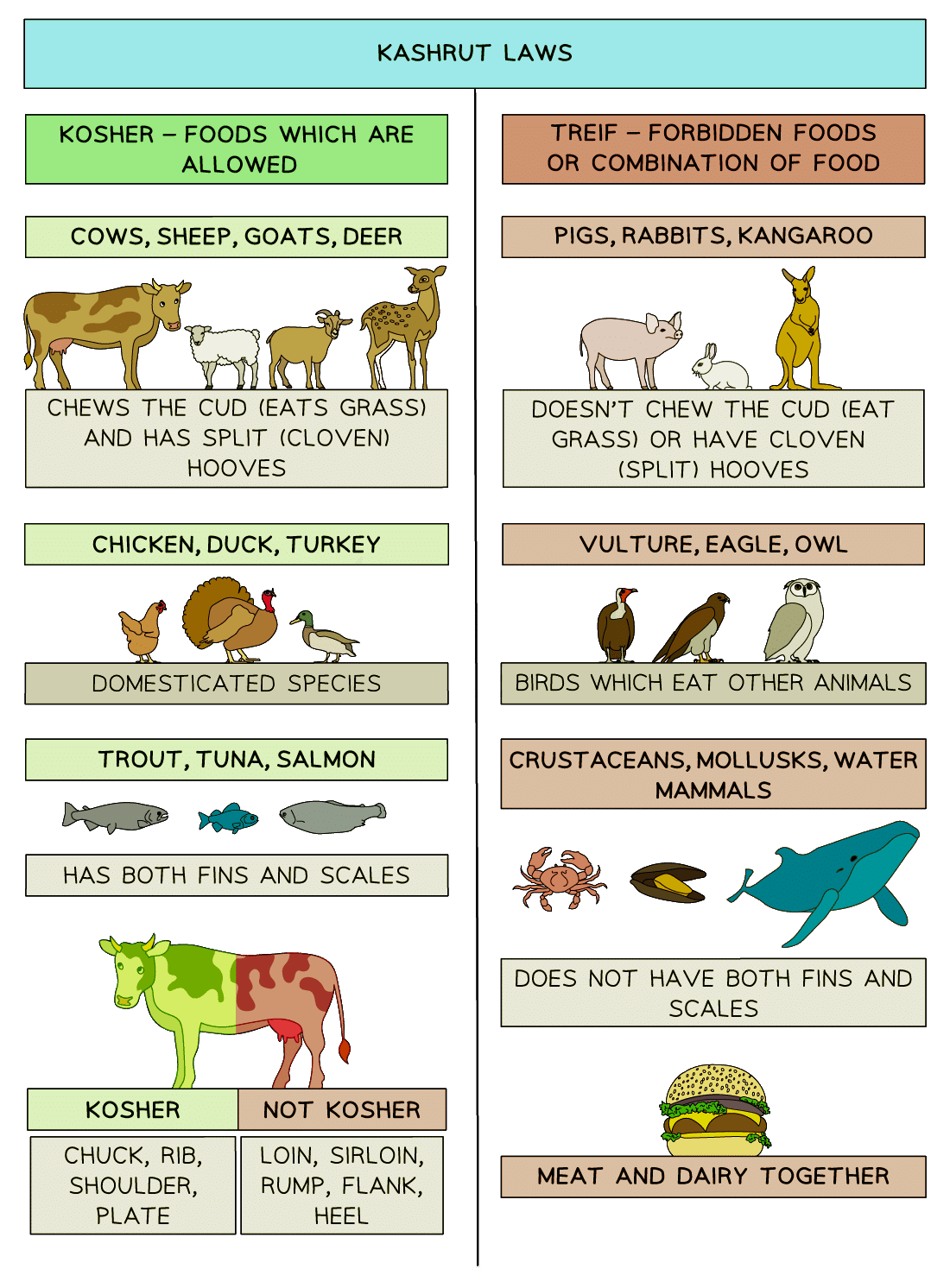Judaism: Dietary Laws | Religion, Philosophy & Ethics for GCSE/IGCSE - Year 11 PDF Download
| Table of contents |

|
| Jewish Dietary Laws |

|
| Kashrut Laws |

|
| Food Laws within Orthodox and Reform Judaism |

|
| Kosher & Trefah |

|
| How do Jews keep Kosher? |

|
| Slaughter & Preparation of Meat |

|
| Separation of Milk & Meat |

|
Jewish Dietary Laws
Jewish dietary laws, known as kashrut, encompass a comprehensive set of rules governing food consumption, preparation, and related practices. These laws are derived from the mitzvot (commandments) found primarily in the Books of Deuteronomy and Leviticus. Adhering to these rules demonstrates obedience and self-control. Foods that comply with these laws are termed kosher (meaning fit or proper), while non-compliant foods are called treif (forbidden).
Kashrut Laws
The kashrut laws cover various aspects of food and its preparation, including:
- Types of Animals: Specifies which animals are permissible for consumption.
- Preparation Methods: Outlines how food must be prepared to be considered kosher.
- Prohibition of Blood: Forbids the consumption of blood, as well as certain fats and sinews.
- Prohibition of Insects: Bans the consumption of flies and insects.
- Separation of Meat and Dairy: Prohibits mixing meat and dairy products, along with other dietary and preparation rules.
Scriptural Basis
The laws are rooted in biblical texts, such as:
- Leviticus 11:3: “You may eat any animal that has a split hoof completely divided and that chews the cud.”
- Example: Pigs have cloven hooves but do not chew the cud, making them forbidden.
- Following these rules reflects adherence to divine commandments and self-discipline.
Food Laws within Orthodox and Reform Judaism
The observance of kashrut varies between Orthodox and Reform Jews:
- Orthodox Jews:
- Strictly adhere to all kashrut rules.
- Often maintain separate utensils and sometimes separate refrigerators for meat and dairy products to prevent mixing.
- Reform Jews:
- View kashrut observance as a personal choice.
- Some follow all kashrut laws, while others observe only certain rules.
- Some maintain kashrut at home but are less strict when eating outside the home.
Kosher & Trefah
- Kosher:
- Means “fit and proper” according to Jewish law.
- Commonly refers to food and diet but can also apply to certain actions.
- Trefah (Treif):
- Refers to forbidden foods or actions that violate Jewish law.
- Examples include shellfish, pork products, rabbit, kangaroo, and meat not slaughtered according to shechitah (proper ritual slaughter).
Specific Kosher Rules
Based on scripture, the following rules govern kosher food:
- Land Animals:
- Must have cloven (split) hooves and chew the cud (e.g., eat grass).
- Seafood:
- Must have fins and scales; shellfish are not permitted.
- Birds:
- Birds of prey are forbidden as they are considered unclean (i.e., they eat other animals).
- Poultry, such as chicken, is allowed.
- Separation of Meat and Dairy:
- Based on Exodus 23:19: “Do not boil a kid in its mother’s milk.”
- Prohibits eating meat and dairy together (e.g., cheeseburgers are not allowed).
- Many Jews wait up to six hours after eating meat before consuming dairy products.
- Parev Foods:
- Neutral foods that can be eaten with either meat or dairy.
- Examples include vegetables, pasta, and rice, provided they are thoroughly washed to ensure no kosher rules are violated.

How do Jews keep Kosher?
- Kosher Food Availability:
- In large UK cities with significant Jewish communities, kosher supermarkets, shops, and restaurants are often located near synagogues.
- In smaller communities, major supermarkets typically have kosher food sections.
- Many food manufacturers produce everyday foods that meet kosher standards.
- Some foods and drinks are labeled parev to indicate they contain no meat or dairy.
- Dining Practices:
- Some Jews avoid eating at non-kosher restaurants, cafes, or dinner parties.
- Reform and Liberal Jews may be less strict when eating out or at friends’ homes.
- Many Jews opt for vegetarian or vegan options when dining out, as these are inherently parev.
Slaughter & Preparation of Meat
Slaughter of Meat
Eating meat is permissible in Judaism, as supported by scripture:
- Deuteronomy 12:21: “Thou shalt slaughter of thy herd and of thy flock, which the Lord hath given thee, as I have commanded thee, and thou shalt eat within thy gates, after all the desire of thy soul.”
- Meat must be prepared according to kosher laws to be considered permissible.
Shechitah (Ritual Slaughter)
- Requirements:
- Meat is considered treif if not slaughtered according to shechitah.
- The shohet (slaughterer) must be a pious, believing Jew proficient in kosher slaughter practices.
- The shohet requires written authorization from a recognized rabbinical authority to confirm their qualifications.
- Process:
- Animals have their throats cut with a razor-sharp knife by the shohet, ensuring immediate loss of consciousness and death to minimize suffering.
- Blood must be completely drained from the animal, as consuming blood is forbidden per Deuteronomy 12:23: “But make sure that you do not partake of the blood; for the blood is the life, and you must not consume the life with the flesh.”
- Additional Prohibitions:
- Animals that die naturally cannot be eaten.
- Slaughtering a parent animal and its young on the same day is forbidden (Leviticus 22:28).
- Meat from animals killed by other animals or afflicted by diseases/disorders causing death is prohibited (Exodus 22:30).
- Regulation:
- The bet din (Jewish tribunal) oversees kosher butchers to ensure compliance with kashrut rules.
Separation of Milk & Meat
The prohibition against mixing milk and meat stems from Exodus 23:19: “Do not boil a kid in its mother’s milk.” This has led to three key rules:
- No Cooking Together: Meat and milk cannot be cooked together, regardless of whether the dish is consumed.
- No Eating Together: Meat and dairy cannot be eaten together, even if not cooked together.
- Utensil Separation: Dairy products and their utensils must be kept separate from meat products and their utensils.
- Some Jewish kitchens have separate counters for meat and dairy to prevent cross-contamination.
- Many Jews wait up to six hours after eating meat before consuming dairy to ensure compliance.
- Example: Cheeseburgers are forbidden as they combine meat and dairy (cheese).

|
172 docs|3 tests
|
FAQs on Judaism: Dietary Laws - Religion, Philosophy & Ethics for GCSE/IGCSE - Year 11
| 1. What are the main principles of Kashrut laws in Judaism? |  |
| 2. How do Orthodox and Reform Judaism differ in their interpretation of dietary laws? |  |
| 3. What is the process of kosher slaughter and how is it performed? |  |
| 4. Why is the separation of milk and meat important in Jewish dietary laws? |  |
| 5. How do Jews manage to keep kosher in modern society? |  |



















